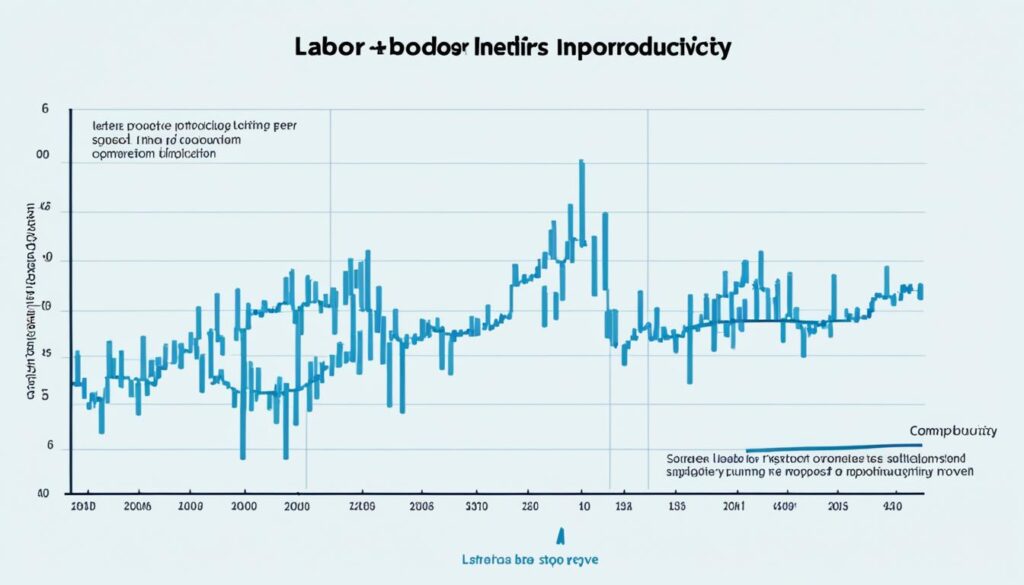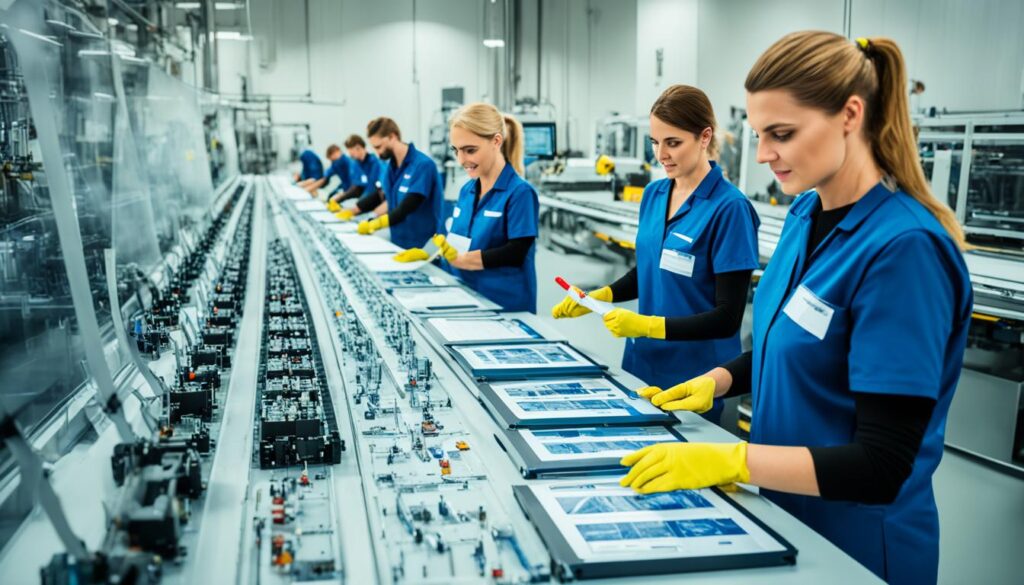Boost Your Efficiency with Labor Productivity Formula

Do you ever find yourself wondering how to maximize your productivity and efficiency at work? Are you looking for ways to improve your performance and achieve better results in less time? If so, you’re not alone. Many professionals strive to boost their efficiency and make the most of their working hours.
But what if there was a formula that could help you measure and improve your labor productivity? A formula that could unlock the secrets to working smarter, not harder? Well, look no further. In this article, we’ll delve into the labor productivity formula and explore how it can transform the way you work.
Key Takeaways:
- Measuring labor productivity is essential for improving efficiency and achieving better results in less time.
- The labor productivity formula allows you to quantify and evaluate your performance at work.
- Investing in physical capital, quality education and training, and technological advancements can enhance labor productivity.
- Measuring and improving labor productivity leads to higher standards of living and increased competitiveness.
- By harnessing the power of the labor productivity formula, you can unlock your true potential and achieve greater success.
Understanding Labor Productivity
Labor productivity, also known as workforce productivity, is a crucial measure in determining the efficiency and effectiveness of a country’s economy. It quantifies the real economic output generated per labor hour, taking into account the quality, efficiency, and output produced by each employee.
Differentiating itself from employee productivity, which focuses on individual worker output, labor productivity provides a comprehensive measure that reflects the overall productivity of the workforce as a whole.
To calculate labor productivity, you need to divide the total output by the total number of labor hours. This formula gives you an accurate representation of the economic output generated relative to the labor invested.
The growth in labor productivity is a significant indicator of improved living standards and economic progress. It signifies the ability to produce more goods and services with the same or fewer resources, leading to increased efficiency and higher overall productivity.
The factors contributing to the growth of labor productivity include:
- Physical capital: Investment in infrastructure, equipment, and technology can enhance the productivity of the workforce.
- New technology: Adoption and utilization of advanced technology can boost efficiency and output.
- Human capital development: Investing in education, training, and skill development empowers workers to perform tasks more effectively and contribute to higher productivity levels.
Visualizing Labor Productivity
Here is a visual representation of how labor productivity is calculated:
| Total Output | Total Labor Hours | Labor Productivity |
|---|---|---|
| 500 units | 100 hours | 5 units per hour |
The table above illustrates a scenario where a total output of 500 units is produced over 100 labor hours, resulting in a labor productivity rate of 5 units per hour.
Understanding and measuring labor productivity is vital for businesses, governments, and policymakers. It allows them to identify areas for improvement, make informed decisions, and implement strategies to enhance productivity effectively.
By harnessing the power of labor productivity, organizations can optimize their resource allocation, improve efficiency, and drive economic growth.

Importance of Measuring Labor Productivity
Measuring labor productivity is crucial for businesses and governments to gauge the efficiency of their workforce and determine the overall economic performance of a country. By understanding and calculating labor productivity, you can gain valuable insights into the factors that impact productivity and make informed decisions to optimize it.
Factors Affecting Labor Productivity
- Investment in Capital Goods: Capital goods, such as machinery and equipment, play a significant role in improving labor productivity. Upgrading and modernizing these assets can streamline production processes and increase output.
- Quality of Education and Training: A well-educated and skilled workforce is more likely to be productive. Investing in continuous learning and providing training opportunities can enhance employees’ knowledge and capabilities, leading to improved productivity.
- Advancements in Technology: Technology has revolutionized the way we work. Embracing technological advancements, automation, and digitalization can significantly boost labor productivity by reducing manual tasks, enhancing efficiency, and enabling employees to focus on more value-added activities.
Measuring labor productivity allows you to assess the efficiency of your labor force and identify areas for improvement. It provides a quantitative measure of the output produced per unit of labor input. This calculation helps monitor the progress of an economy, detect short-term fluctuations, and evaluate the impact of various economic policies and initiatives.
Labor Productivity Calculation
The labor productivity ratio formula is relatively straightforward:
Labor Productivity Ratio = Total Output ÷ Total Labor Hours
This formula measures the amount of output generated by each hour of labor input. It provides an indicator of the efficiency and effectiveness of your workforce.
By regularly evaluating labor productivity, you can uncover potential bottlenecks, inefficiencies, or areas where employees may require additional support and resources. This data-driven approach enables you to make informed decisions to enhance productivity, allocate resources effectively, and drive overall business growth.
Sample Table: Labor Productivity Comparison
| Year | Total Output (in units) | Total Labor Hours | Labor Productivity Ratio |
|---|---|---|---|
| 2018 | 10,000 | 5,000 | 2 |
| 2019 | 12,000 | 5,500 | 2.18 |
| 2020 | 14,000 | 6,000 | 2.33 |
Table: Comparison of Labor Productivity Ratio Over Three Years
The table above illustrates the labor productivity ratio over a span of three years. As you can see, the labor productivity ratio increased from 2 in 2018 to 2.33 in 2020. This indicates an improvement in efficiency and output per labor hour, reflecting positive growth and progress.
Measuring labor productivity provides valuable insights that can guide strategic decision-making, drive process improvements, and foster a culture of continuous productivity enhancement within your organization. By optimizing labor productivity, you can achieve higher levels of efficiency, profitability, and sustainable business success.

Formula and Metrics for Labor Productivity
Improving labor productivity is a key goal for businesses and organizations. To effectively measure and optimize labor productivity, various formulas and metrics are utilized. These tools provide valuable insights into resource utilization, individual performance, and overall efficiency.
Formula for Labor Productivity
The labor efficiency equation is a fundamental formula used to calculate labor productivity. It measures the ratio of output to input, providing an overall measure of productivity. This formula is calculated by dividing the total output by the total input.
Labor Efficiency Equation: Output / Input
For example, if a manufacturing company produces 1,000 units in a month and employs 100 labor hours, the labor efficiency equation would be:
1,000 units / 100 labor hours = 10 units per labor hour
Other Formulas for Labor Productivity
In addition to the labor efficiency equation, there are other formulas that can be used to measure labor productivity in specific contexts. One such formula is the partial factor productivity, which calculates the ratio of total output to a single input. This formula provides insights into the productivity of a particular input.
Another formula is the multifactor productivity, which relates output to a subset of inputs, such as labor, capital, and materials. This formula allows organizations to analyze the combined productivity of multiple inputs.
Productivity Metrics
Productivity metrics go beyond formulas and provide additional insights into labor productivity. These metrics help organizations identify areas for improvement and benchmark performance.
One common productivity metric is revenue per employee, which measures the amount of revenue generated by each employee. This metric can highlight disparities in productivity between different teams or departments.
Another metric is the focus work and meeting rates, which measures the percentage of time employees spend on focused work versus time spent in meetings. This metric provides insights into time management and the effectiveness of meetings.
By leveraging these formulas and metrics, businesses can gain a comprehensive understanding of their labor productivity and identify strategies to improve efficiency and optimize performance.

Comparing Labor Productivity Formulas and Metrics
| Formula/Metric | Description |
|---|---|
| Labor Efficiency Equation | The ratio of output to input, providing an overall measure of productivity. |
| Partial Factor Productivity | The ratio of total output to a single input, measuring the productivity of that specific input. |
| Multifactor Productivity | Relates output to a subset of inputs, allowing the analysis of combined productivity across multiple inputs. |
| Revenue per Employee | The amount of revenue generated by each employee, highlighting disparities in productivity. |
| Focus Work and Meeting Rates | The percentage of time employees spend on focused work versus time spent in meetings, measuring time management effectiveness. |
Policies to Improve Labor Productivity
To enhance labor productivity, the implementation of effective policies is crucial. These policies focus on improving the factors that drive productivity, promoting efficiency, and fostering competitiveness in businesses and economies.
Investment in Physical Capital
Investing in physical capital, including infrastructure development, plays a significant role in enhancing labor productivity. By improving the quality and availability of infrastructure, such as transportation networks and utilities, businesses can operate more efficiently and effectively. This not only boosts productivity but also lowers the cost of doing business.
Quality Education and Training Opportunities
To improve labor productivity, providing workers with quality education and training opportunities is essential. By equipping employees with the necessary skills, knowledge, and expertise, they can perform their jobs more efficiently and contribute to higher productivity levels. Upskilling and continuous learning programs enable individuals to stay updated with industry trends and technological advancements, leading to improved productivity.
Technological Progress
The advancement of technology, both in terms of hard and soft technologies, plays a vital role in enhancing labor productivity. Embracing new technologies and integrating them into business operations can streamline processes, automate repetitive tasks, and increase overall efficiency. From adopting state-of-the-art equipment and machinery to implementing advanced software solutions, technological progress can significantly enhance worker productivity.
By implementing these policies, businesses and governments can foster an environment of continuous improvement and optimization. This not only boosts labor productivity but also strengthens the overall economy, driving sustainable growth and prosperity.

| Policies to Improve Labor Productivity |
|---|
| Investment in Physical Capital |
| Quality Education and Training Opportunities |
| Technological Progress |
Conclusion
Measuring and improving labor productivity is essential for maximizing efficiency and achieving success in both business and government sectors. Recognizing the influential factors of physical capital, new technology, and human capital is key to enhancing labor productivity. By implementing the labor productivity formula, businesses can assess their performance, identify areas for improvement, and make informed decisions to increase productivity.
Policies focusing on investment in physical capital, quality education and training, and technological progress play a vital role in elevating labor productivity. Investment in physical capital, including infrastructure, enables businesses to enhance productivity and reduce operational costs. Quality education and training opportunities empower workers to upgrade their skills, ensuring they contribute to higher overall productivity. Technological advancements, both in hardware and software, can significantly boost worker efficiency.
Improving labor productivity not only leads to improved standards of living and higher consumption but also enhances competitiveness for businesses and economies. By harnessing the power of the labor productivity formula, companies can unleash their full potential and optimize their resource utilization. This, in turn, enables them to thrive in today’s dynamic and challenging market landscape.






